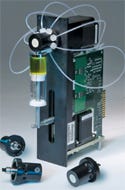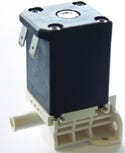Through innovation and customer input, pump and valve providers are finding ways to offer flexible products.
November 11, 2007
Originally Published MPMN November 2007
PRODUCT UPDATE
Finding a Niche in the Flow Path
Through innovation and customer input, pump and valve providers are finding ways to offer flexible products.
|
A drive pump from Hamilton OEM incorporates an eight-port ceramic valve and can accept large syringes up to 25 ml. |
Pumps and valves are ubiquitous in medical manufacturing, serving as components in equipment and in finished medical devices. For OEMs, selecting the best flow-control component for a given application can be a daunting process. Providers offering custom design services can often meet the demands of highly specialized applications, but finding the right standard components remains challenging. The good news for OEMs is that pump and valve providers are finding ways to increase product flexibility, thereby increasing the number of choices available. Greater component flexibility can allow an OEM to use a proven component from a separate application--even a separate industry--for the medical manufacturing task at hand.
One Size Does Not Fit All
Suppliers are hearing the call for increased applicability from OEMs. "Often they want something very similar to a valve you already offer--just a little different shape, material, even a different color if they want to distinguish the product," says Steve Bello, sales engineer for Halkey Roberts (St. Petersburg, FL; www.halkey-roberts.com). "The key is to stay flexible."
To answer the call for flexibility, the company is offering new swabbable tube-end valves with pockets that can fit five different sizes of tubing: 2, 2.5, 2.8, 3.7, and 4-mm ID. In addition, the luer valve line does not exclusively consist of tubing valves. Standard valve stems and bodies mate securely with all standard luer syringes and connectors, and a bag-end valve can connect directly to a solution bag. This can provide a simple solution for converting a needle port on a bag to a needle-free access site. Developed for medical applications where needle-free access is required along with a closed fluid path, the disposable valves are suitable for an array of IV set applications.
Size matters for pumps as well. A new 60-mm syringe drive pump from Hamilton OEM (Reno, NV; www.hamiltoncompany.com) can accept a variety of large syringe sizes, up to 25 ml. The switch-and-go pump incorporates an eight-port ceramic valve and is driven by a dc stepper motor. It includes both logic and driver boards. Performing all liquid-handling operations including dispensing, serial dispensing, and diluting, the pump operates on 24 V dc and can be used either as a single unit or connected together in series from a single serial port to form a bank of as many as 16 modules. Backward compatible, the component can fit the full-height envelope size of most other pumps.
The company can attest to the importance of flexible stock supplies. Often Hamilton OEM uses its own standard products in designing custom systems, making it, in effect, a customer of its own catalog. "The pump expands on our established syringe pumps to meet more applications," says Chris Powers, OEM product support manager. "By accepting large syringes, the pump can distribute flows for a variety of applications with the same component."
Same Valve, Cleaner Applications
|
A plastic-encapsulated plunger is the only moving part on this valve from Diener Precision Pumps. |
Size isn't the only modification that can lead to greater flexibility, as demonstrated by Clippard Instrument Laboratory (Cincinnati, OH; www.clippard.com), a provider of miniature pneumatic components. The E-V oxygen valve had long been one of the company's successful offerings, but recently the firm discovered a way to broaden the valve's appeal beyond its original applications.
"We heard from customers who used the valve in the past and were happy with it, but now want to use it for applications requiring greater cleanliness," says Rich Humason, senior design engineer. "They needed a version of the valve that kept out hydrocarbon matter and particles, and out of this request came a whole new product series."
The result is the O-E series of electronic oxygen valves. Available in two- or three-way configurations that are normally closed or fully ported, the valves are designed for use with oxygen applications and will work with air and inert gas. With power consumption of 0.67 W, response times of 5 to 10 milliseconds, and voltages of 6, 12, or 24 V dc, the valves are, like their E-V forbearers, meant to offer design flexibility. The O-E valves are ultrasonically cleaned, assembled, inspected, and tested in an enclosed, controlled area that has a HEPA filtration system. The valves are suitable for a variety of OEM manufacturing applications, as well as for respiratory systems.
Reaching Out with Innovation
Sensitive and aggressive fluids present medical OEMs across different flow-control applications with similar challenges. Diener Precision Pumps Inc. (Lodi, CA; www.dienerprecisionpumps.com) believes it can help. In dealing with such fluids, a hermetically sealed flow path is usually required. But in preventing contamination or leakage, a new problem can arise. In generating enough internal pressure to control flow, the valves on a dialysis machine, for example, can become quite hot. The fluid flowing through the valves, in turn, can increase in temperature, and unregulated fluid temperature can be just as detrimental as unwanted microorganisms.
A new valve from Diener rests on what the company describes as an innovative, yet simple, principle: "The plunger, which is plastic-encapsulated, is the only moving part, and it's controlled by magnetic forces that operate through the wall of the valve," explains John Bishop, director of sales and marketing. "Due to the use of magnetic force, there is no heat in the flow path. The valve is totally cold."
In addition to dialysis systems, the two- and three-way monostable solenoid valve is flexible enough to meet the demands of fluid-analysis systems and other OEM applications where the handling of difficult fluids is involved. The valve is plastic, and, despite its seal and temperature requirements, features low power consumption, according to the company.
Copyright ©2007 Medical Product Manufacturing News
You May Also Like




